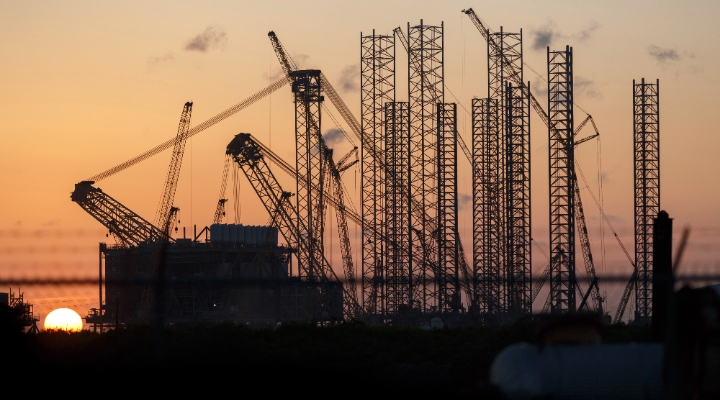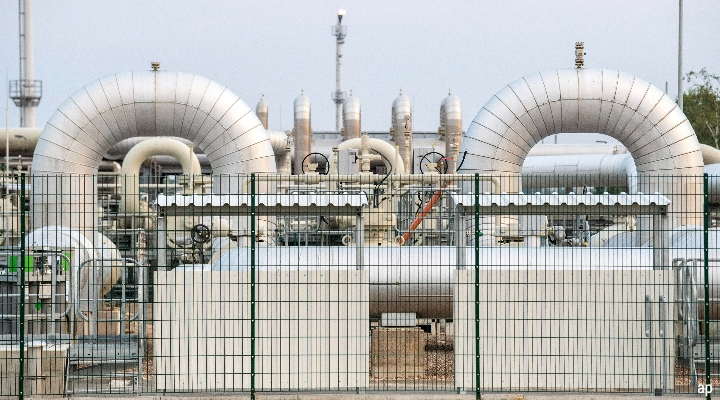
Natural gas prices in Europe have been volatile this spring amid colder weather and lower supplies from Norway. But as we head into summer, the European Union is already preparing for the next winter.
So far the outlook is promising: European gas storage stocks are 63.2% full (as of May 5), a level higher than in 2023 and higher of the average of the last five years (47%). This level is second only to what was seen in 2020, when the collapse of global demand in the covid pandemic pushed futurescontracts below €9. And one analyst is predicting that European gas storage could reach 100% capacity by the start of the 2024 winter. But there are risks ahead as Chinese demand for LNG increases and Europe competes for supplies.
On the Dutch TTF market, the front-month natural gas future is trading at around €31 per megawatt-hour (on May 8), the same level as three years ago, and almost half the €54/MWh reached on October 8 last year, the day after the Hamas attack on Israel that triggered a massive military counteroffensive.
"Natural gas prices in Europe experienced a fair amount of volatility in April," said Warren Patterson, head of commodity strategy at ING, in an analysis released on May 7.
“One-month futures on TTF rose from just over €25/MWh at the beginning of April to almost €34/MWh by mid-month, before falling below €30/MWh at the end of the month. However, prices rose again at the beginning of May. Reduced Norwegian gas flows to Europe and a late cold spell across much of the continent increased heating demand in the second half of April."
According to Patterson, however, this volatility will be transient: “Europe will reach 100% storage before the start of the next heating season."
"This should keep downward pressure on prices and we expect the TTF to average €25/MWh for the rest of the pre-winter season."
The table below shows the differences between countries in terms of gas storage.
EU Less Dependent on Russia Energy
Following the Russian invasion of Ukraine, the EU succeeded in abandoning Russian gas imports. After the painful increases in energy prices in 2022, we have seen a steady decrease, thanks to a combination of mild weather and falling demand. At the same time, LNG (liquefied natural gas) imports and the infrastructure to support them are growing rapidly.
According to data from Bruegel, a Brussels-based political-economic thinktank, theEU reduced Russian fossil fuel imports from a maximum of $16 billion per month at the beginning of 2022 to around $1 billion per month by the end of 2023.
While Russia no longer enjoys the extraordinarily high export earnings it did early 2022, its revenues from fossil fuel exports are still comparable to those of 2019, mainly because the country has shifted oil and gas exports to China, India and Turkey. To compensate for the reduction in Russian imports, Europe has increased imports from other countries.
Europe Needs More LNG
Globally, demand for LNG is at record levels. While Europe is importing an increasing amount of LNG, it is also in competition with China for the commodity.
Europe’s LNG imports doubled from 20% in 2019 to 40% in 2023, thanks mainly to a fivefold increase in imports from the US. Imports of Russian LNG also increased, but in absolute terms this increase represented less than 10% of the gas transit through the Nord Stream pipeline when it was operational.
According to Energy Outlook Advisors (EOA), ship tracking data shows that global LNG demand reached an all-time high in 2023, to 401 million tonnes (mt), up from 390 mt in 2022, which itself had already been a record year. This demand comes amid limited additions of new capacity and lower spot prices compared than in 2022.
This increase in LNG demand has made European countries vulnerable to market volatility, especially since 70% of these imports are purchased on short-term contracts. Last year, exceptionally mild winter weather reduced heating demand in both Europe and Asia. Besides the mild weather, the economic slowdown experienced in China between 2022 and the first part of 2023 reduced Beijing's LNG imports, but this could be changing.
Chinese Economy Stirs Again
Driven by Chinese demand, Asia remained the top destination for seaborne LNG cargoes in 2023, receiving more than 258 mt or 64% of global demand. And according to EOA's data, China overtook Japan as the world's largest LNG importer last year, with a 13.7% increase in its imports, after Chinese gas demand in 2022 was affected by industry weakness due to covid control measures and high LNG spot prices caused by an unprecedented European demand.
Now, however, the Chinese economy is showing signs of awakening: the first quarter of 2024 saw GDP growth of +5.3% year-on-year, above market expectations, even higher than the already ambitious target that the Beijing government had set for itself (which predicted growth of around +5%).
And indeed, according to estimates by China's state-controlled Economics and Technology Research Institute (ETRI), total Chinese imports of natural gas, both piped and liquefied by ship, reached an all-time high in the first quarter at 33 mt. March alone saw a 21% jump year on year. At the same time, according to the ETRI, China is expected to add a record 60 mt per year of new LNG receiving capacity in 2024, bringing its total LNG receiving capacity to 176 mt per year, a 52% increase from 2023.
According to the US Energy Information Administration (EIA), “growing LNG consumption in Asia is a key uncertainty with potentially major implications for global markets”.
“The lack of long-term contracts in Europe increases supply risk during cold weather and price spikes and may also intensify competition for spot LNG between regions”. Not least because, as EIA analysts point out, global LNG markets will see modest supply increases in the coming years.
Prices Likely to Remain Volatile
So there are plenty of unknowns. "Gas prices in Europe are likely to remain volatile for some time as the EU has to compete with the more price-sensitive China and to a lesser extent India and Thailand for LNG cargoes," says Stephen Ellis, a strategist at Morningstar specialising in utilities.
"This dynamic introduces greater price unpredictability, as the reliability of LNG cargoes is not guaranteed in the very short term at the most optimal price."
However, the market does not currently expect huge spikes in the coming months. On the TTF, natural gas futures contracts maturing in December 2024 are trading at €37.5/MWh (around 20% above current levels), while those for January and February 2025 are trading at around €37.9/MWh.
"As storage facilities in the EU and the US are very full, gas prices are likely to remain extremely low through 2024, before recovering in 2025 as renewed demand for LNG comes on stream," Ellis adds.
In this context, Morningstar analysts believe that the best opportunities are represented by companies that leverage gas demand at discounted prices, such as Kinder Morgan (KMI) and TC Energy (TRP), which will benefit from increased demand and supply of LNG feedstock.
The table above also shows which exchange traded commodity funds have exposure to natural gas.




























